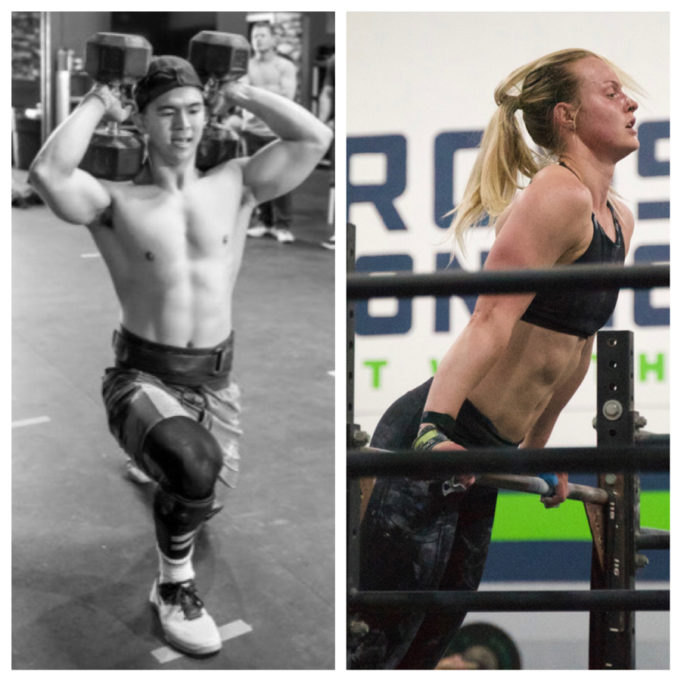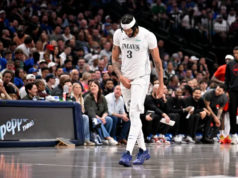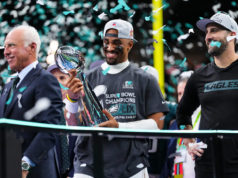I’m not sure if anyone in my social circle does CrossFit. If you aren’t confident you know anyone who’s been baptized into the fitness cult, then you probably don’t — only vegans and Jehovah’s Witnesses are more eager to talk about their lifestyle choices. Chances are if there’s a functional fitness fanatic in your life, you’re already frequently subjected to them speaking in coded acronyms while your eyes glaze over. Yet even if you don’t know anyone personally, you’re about to be acquainted with the two fittest Fort Worthians.
But first, some background. One of the most quotable lines from HBO’s acclaimed Eastbound and Down series came when the disgraced former pro baseball player at the center of the show was asked about the exercise regime of a triathlete: “I play real sports, not trying to be the best at exercising.” And I’m sure some sports purists think the same about CrossFit. Why would anyone train to be the best at training? Well, like it or not, CrossFit is mainstream, especially amazing considering its brief lifespan. An exercise class according to some, a lifestyle cult if you ask others, CrossFit is both and more. According to the company and its founder, it’s constantly varied functional movements executed at high intensity. If that sounds obtuse, that’s because it is, purposely.
As a training style, it’s what would happen if gymnastics, Olympic weightlifting, and calisthenics combined for a cocaine-fueled romp in the sack, and it’s exploded in popularity since it was conceived in 1996 and trademarked in the year 2000. If you were to compare CrossFit to a more established sport, it’s like a decathlon but the events constantly change. It didn’t take participants and the parent company a decade to realize the potential for a championship of fitness, and thus the CrossFit Games were born in 2007.
The Super Bowl of exercise has evolved over the last 14 years and grown to attract all the trimmings associated with high-profile sports: corporate sponsorships, cottage equipment industries, substantial prize money, and full-time professional athletes.
The CrossFit Games, dissimilar to other sports, holds almost zero barriers to entry. Anyone older than 14 with $20 — this year’s registration fee — can compete through the online qualifying process called the CrossFit Open. Known to the fitness community as simply “The Open,” the worldwide qualifier began in 2011 and has been an online first-stage competition predating the pandemic necessity of remote everything. Open workouts are traditionally performed at CrossFit gyms in the presence of a certified judge who will count and approve each individual rep of whatever workout is being performed. If a participant scores well enough, compared to other competitors, they’ll be allowed to advance to one of several regional-level meets. A small percentage of those regional athletes will advance to the CrossFit Games (traditionally 30 men and 30 women), once held in Carson, California, and now in Madison, Wisconsin. The company of CrossFit suffered scrutiny and controversy last summer thanks to the fumblings and general grossness of former CEO and founder Greg Glassman. The new CEO, Eric Roza, introduced changes to The Open that would make it possible for more competitors to advance to a newly conceived online quarterfinal stage. The initial online competition, which was shortened from five weeks to three this year, releases a workout on Thursday, and a certified score must be posted by the following Monday evening to count. The top 10% of males and females on each continent are then invited to proceed to the second stage in which they would receive five workouts on a Thursday and need to perform all of them and submit their results — judged, as well as videotaped this time — by Monday for a chance to qualify for an in-person sanctioned event to qualify for the CrossFit Games.
James Kim recently finished 739th on the worldwide Open leaderboard. That might not seem impressive to the uninitiated, but that was out of more than 137,000 registered participants, placing him in the top 5% of all male CrossFitters with his open performance.
A native of Virginia, Kim has been following a functional fitness workout routine since he was in college while working out in traditional big-box gyms. For many years, he was a “main siter,” meaning he worked out on his own along with whatever workout was posted on at CrossFit.com. A club lacrosse player in college, Kim was attracted to the training style after watching top-level competitors and intrigued by their overall fitness and skills.
For this Marine Staff Sergeant, fitness has always been a pillar of his life. When asked for specificity about his work in the Marine Corps, the 31-year-old smiled and said he was with a special unit. Not wanting to jeopardize my safety, we moved on from there. After moving to Fort Worth to be closer to his wife’s family, Kim needed a new CrossFit gym to call home and found it at CrossFit Iron Horse near Como. Iron Horse is owned by Candice Wagner, a former Marine, who has appeared three times in the CrossFit Games, in 2010, 2012, and 2016, and has finished as high as 17th. Kim was able to find community there upon moving to Cowtown and a competitive environment. His talent was well utilized when the affiliate qualified a four-person team (two men, two women) to a regional event in 2018. While training at Iron Horse, Kim made a close connection with Matt Haynes, who convinced him to move gyms when Haynes took ownership of CrossFit Westwood near the Hospital District. Kim, who said he trained at home most of the pandemic because he and his wife were expecting their first child, is a certified coach but said he will fill in sparingly between his new-father duties and Marine obligations that regularly send him back to Washington, D.C. Kim’s child arrived safely, if not inconveniently, during the rolling blackouts of our historic winter storm. His fitness results indicate he weathered the storm and additional responsibilities masterfully as his placement in The Open suggests.
The Marine reservist said he mostly continues training to stay fit for his career and keep up with raising his children, but he still holds fire for perhaps reaching an individual regionals competition or returning with a team in the future. He stayed performance-ready during the pandemic by completing similar online competitions from his home gym. Despite earning an invitation, Kim declined the opportunity to compete in the quarterfinals stage, as it would have required him to make special arrangements with work and put a pause on his parenting duties with a newborn. As might be expected in a niche-sport world, our fittest male and female already knew each other.
Megan Conger, a 22-year-old recent TCU graduate, is also a CrossFit coach and currently trains with Wagner at Iron Horse. Another transplant from the Mid-Atlantic, Conger is originally from Maryland and a former collegiate volleyball player. I caught up with our fittest female roughly a week after completing her quarterfinals workouts as she was preparing to return to her regular training the next day. She represents the older of the new guard in the sport of fitness, those who have been aware that they’ve wanted to compete since their teenage years.
Transferring to TCU after an Achilles injury ended her volleyball career, Conger began training specifically for CrossFit, coachless, at TCU’s rec center.
“I was broke and didn’t have a car at the time,” she said.
She was working at Righteous Foods on West 7th Street and learned of CrossFit Iron Horse nearby, eventually approaching Wagner, who took her on as an athlete and employee at her gym. Still a novice in terms of competition, Conger competed at the Fittest Experience in Austin during her first live throwdown in January. This Open, her second, she finished 1,176 out of more than 108,000 women, an impressive score despite dealing with a back injury dating back to the pandemic.
Similarly to Kim, Conger found respite from lockdown by teaming up with a neighbor who owned equipment so she could stay on top of her training while gyms were closed. Different from her friend and former gymmate, Conger’s expectations and career in competition are just beginning. She is forgoing graduate school for now so that she can fully focus on her training, which is normally three to four hours per day as well as the mobility, rehab, and yoga that come along with that level of intensity. Despite a singular focus on performance, the devout Catholic said she makes time to attend Mass most mornings. Both Kim and Conger spoke more than once about their religious faith being paramount in their lives and guiding them in surprising directions.
During quarterfinals, she finished 832nd of 3,408 competitors who were whittled down from The Open, which seats her in an elite group of the top 3% of CrossFit women overall. Conger said she also plans to stay in Fort Worth and continue coaching at Iron Horse and working at Righteous Foods, which tops her list of recommendations for health-minded folks seeking a delicious bite.
Believe it or not, CrossFit is a real sport and has been for some time. If you fancy yourself a fit athlete, I might advise you to register for The Open next year or head down to CrossFit Westwood or Iron Horse and take a class with one of these machines before you lie to yourself that CrossFitters aren’t playing real sports but are simply being the best at exercising.












